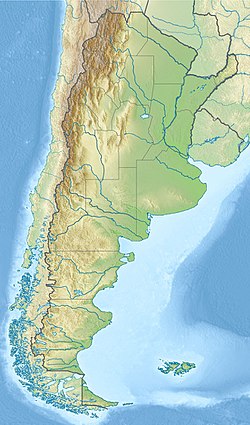Lecho Formation
| Lecho Formation | |
|---|---|
| Stratigraphic range: Early Maastrichtian ~ | |
| Type | Geological formation |
| Unit of | Salta Group |
| Underlies | Yacoraite Formation |
| Overlies | Los Blanquitos Formation |
| Lithology | |
| Primary | Sandstone |
| Location | |
| Coordinates | 26°06′S 65°24′W / 26.1°S 65.4°W |
| Approximate paleocoordinates | 28°36′S 52°00′W / 28.6°S 52.0°W |
| Region | Jujuy, Salta |
| Country | Argentina |
| Extent | Salta Basin |
The Lecho Formation is a geological formation in the Salta Basin of the provinces Jujuy and Salta of northwestern Argentina. Its strata date back to the Early Maastrichtian, and is a unit of the Salta Group. The fine-grained bioturbated sandstones of the formation were deposited in a fluvial to lacustrine coastal plain environment.
Dinosaur remains are among the fossils that have been recovered from the formation.[1]
According to Frankfurt and Chiappe (1999), the Lecho Formation is composed of reddish sandstones. The Lecho is part of the Upper/Late Cretaceous Balbuena Subgroup (Salta Group), which is a near-border stratigraphic unit of the Andean sedimentary basin. Fossils from this formation include the titanosaur Saltasaurus along with a variety of avian and non-avian theropods.
Fossil content
[edit]Dinosaurs
[edit]| Dinosaurs from the Lecho Formation | |||||
|---|---|---|---|---|---|
| Genus | Species | Location | Material | Notes | Images |
| Abelisauridae[2] | Indeterminate | El Brete | Isolated teeth. | May represent more than one species of abelisaurid | |
| Elbretornis[3] | E. bonapartei | El Brete | Scapula, partial coracoid, humerus, partial radius, partial ulna | An enantiornithine bird | |
| Enantiornis[3][4] | E. leali | El Brete | Postcranial elements | An enantiornithine bird | |
| Euenantiornithes indet.[3] | Indeterminate | El Brete | Partial right lower jaw | An enantiornithine bird | |
| Lectavis[5] | L. bretincola | El Brete | Tarsometatarsus and tibiotarsus | An enantiornithine bird |  |
| Martinavis[3] | M. minor | El Brete | Partial humerus | An enantiornithine bird | |
| M. saltariensis | El Brete | Humerus | |||
| M. vincei | El Brete | Humeri | |||
| M. whetstonei | El Brete | Partial humerus | |||
| Noasaurus[2] | N. leali | El Brete | Isolated elements from the head and foot, as well as a verebral arch. | A Noasaurid abelisaur |  |
| Saltasaurus[6] | S. loricatus | El Brete | "Partial skeletons of at least [six] individuals, including jaws and armor."[7] | A saltasaurid titanosaur |  |
| Soroavisaurus[5] | S. australis | El Brete | Tarsometatarsus and phalanges. | An enantiornithine bird |  |
| Yungavolucris[5] | Y. brevipedalis | El Brete | Tarsometatarsi | An enantiornithine bird | |
See also
[edit]References
[edit]- ^ Weishampel et al., 2004, "Dinosaur distribution (Late Cretaceous, South America)." pp. 600-604
- ^ a b Hendrickx, Christophe; Cerroni, Mauricio A; Agnolín, Federico L; Catalano, Santiago; Ribeiro, Cátia F; Delcourt, Rafael (2024-12-01). "Osteology, relationship, and feeding ecology of the theropod dinosaur Noasaurus leali, from the Late Cretaceous of North-Western Argentina". Zoological Journal of the Linnean Society. 202 (4). doi:10.1093/zoolinnean/zlae150. ISSN 0024-4082.
- ^ a b c d Cyril A. Walker; Gareth J. Dyke (2009). "Euenantiornithine birds from the Late Cretaceous of El Brete (Argentina)" (PDF). Irish Journal of Earth Sciences. 27: 15–62. doi:10.3318/IJES.2010.27.15. S2CID 129573066. Archived from the original (PDF) on 2012-03-20.
- ^ Walker, C. A. (1981). "New subclass of birds from the Cretaceous of South America". Nature. 292 (5818): 51–53. doi:10.1038/292051a0. ISSN 0028-0836.
- ^ a b c Chiappe, Luis (1993). "Enantiornithine (Aves) tarsometatarsi from the Cretaceous Lecho Formation of northwestern Argentina". American Museum Novitates (3083): 1–27. S2CID 39613970.
- ^ Zurriaguz, Virginia; Powell, Jaime (2015-05-01). "New contributions to the presacral osteology of Saltasaurus loricatus (Sauropoda, Titanosauria) from the Upper Cretaceous of northern Argentina". Cretaceous Research. 54: 283–300. doi:10.1016/j.cretres.2014.12.012. ISSN 0195-6671.
- ^ "Table 13.1," in Weishampel et al., 2004, p.270
Bibliography
[edit]- Walker; Dyke (2009), "Euenantiornithine birds from the Late Cretaceous of El Brete (Argentina)", Irish Journal of Earth Sciences, 27: 15–62, doi:10.3318/IJES.2010.27.15
- Agnolin, F.L.; Martinelli, A.G. (2007), "Did oviraptorosaurs (Dinosauria; Theropoda) inhabit Argentina?" (PDF), Cretaceous Research, 28 (5): 785–790, Bibcode:2007CrRes..28..785A, doi:10.1016/j.cretres.2006.10.006
- Weishampel, David B.; Dodson, Peter; Osmólska, Halszka (2004), The Dinosauria, 2nd edition, Berkeley: University of California Press, pp. 1–880, ISBN 0-520-24209-2, retrieved 2019-02-21
{{citation}}: CS1 maint: publisher location (link) - Frankfurt, N.G.; Chiappe, L.M. (1999), "A Possible Oviraptorosaur From The Late Cretaceous of Northwestern Argentina", Journal of Vertebrate Paleontology, 19 (1): 101–105, Bibcode:1999JVPal..19..101F, doi:10.1080/02724634.1999.10011126

